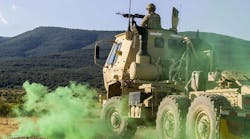The U.S. Army has awarded General Micro Systems (GMS) a contract worth as much as $88 million for computer server and display systems to run the multifunction video display (MVD) in Type II medium mine protection vehicles (MMPVs). The contract provides a compact and rugged server (see photo) and display system employing the same Intel Xeon E5 microprocessors used in the latest “Pro” brand consumer products from Apple.
“For the first time, the U.S. Army will have deployed military technology that is as leading-edge as the latest and best-available commercial technology in the consumer market,” said Ben Sharfi, CEO and chief architect for GMS.
The server and display system will provide MRAP mine-clearing vehicles with the capability to run the Army’s advanced MVD software. The combination of hardware and software enable display of full-motion video and systems control in real time with minimal latency from all sensor systems in MMPV vehicles.
“The MVD system uses the most powerful processing technology available to keep our soldiers safe,” said Sharfi. “We worked closely with the Army to ensure the system was designed with the latest and highest performing server, networking, image processing, and storage capability.
“The result is unprecedented,” he added, “and for the first time that we’re aware, the Department of Defense is deploying the latest commercial-off-the shelf system based on the same processors used by one of the world’s greatest technology companies, Apple.”
The advanced server and display system was developed in response to the Army’s need for full situational awareness at all times. The system is designed to integrate full-motion video from all sources at all vehicle crew stations, and distribute images and sensor control to all crew stations within a vehicle, offering a standardized view of data from multiple sensors.
Control is performed via a common interface for all crew stations, each with a touchscreen display for ease of control and data access. Each networked crew station operates independently such that one crew member can control one sensor system while a second simultaneously controls or views another. The system allows soldiers to navigate without direct sight, and offers capabilities that can easily be applied across other tactical applications.


